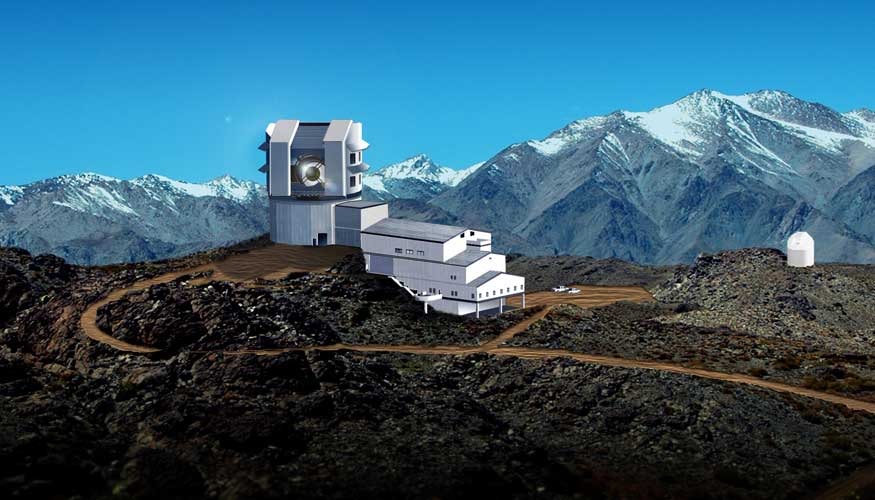From The NSF NOIRLab NOAO Gemini Observatory

International Gemini Observatory/NOIRLab/AURA/NSF/M. Paredes
5.20.24 [Just today from the institution]
LAURA HISCOTT
With one telescope high in the Chilean mountains, and another on a towering dormant volcano, the International Gemini Observatory offers some of the world’s most pristine views of the night sky.




But observing from these lofty altitudes sometimes means being close to a region of intense geological activity. So how do engineers protect the telescopes’ fragile mirrors from the risk of earthquake damage?
At first glance, the locations of the International Gemini Observatory’s twin 8-meter telescopes in Chile and Hawai‘i might seem perfect. And in many ways they are. At over 2722 meters (8930 feet) and 4214 meters (13,825 feet) above sea level respectively, the telescopes enjoy exceptionally low levels of clouds, humidity and light pollution. And being separated across hemispheres they together offer a view of the entire sky, enabling astronomers to make groundbreaking discoveries about the Universe we live in. But there is one thing about both Gemini telescopes’ locations that poses a unique challenge.
Around 150 kilometers (100 miles) off the coast of Chile, deep on the floor of the Pacific Ocean, runs the Peru-Chile Trench — a seam in the Earth’s surface that skirts much of South America’s western coast.

The Peru-Chile oceanic trench. http://www.ngdc.noaa.gov/mgg/image/2minrelief.html
Along this seam, the Nazca Plate is being subducted, or pushed below its neighbor, the South American Plate. This subduction unfolds in a series of sporadic earthquakes caused by pressure build-up, sending shudders throughout the whole region, potentially reaching the ground on which the Gemini South telescope’s foundation rests.
Across the Pacific Ocean in Hawai‘i, the identical Gemini North telescope faces a similar danger. This half of the Gemini Observatory sits on the dormant volcano Maunakea in Hawai‘i.

A view of the Mauna Kea volcano of Hawaii from the ocean. Vadim Kurland
This location boasts an astronomically appealing altitude, but it’s surrounded by four active volcanoes in a region where rumbling magma and occasional eruptions can shake the ground.
In light of this peril, one might wonder why such expensive, precision-engineered pieces of equipment would be built in places with a lot of tectonic activity. The answer to that question reveals an irony at the heart of this problem. The hazardous quakes that threaten the integrity of the telescope’s infrastructure and important scientific equipment go hand-in-hand with the forming of the mountainous landscapes that make these locations such excellent spots for studying the cosmos.
The challenge for engineers, therefore, is to design systems that can prevent damage to these invaluable research facilities if and when they are subjected to powerful shockwaves. “Protective systems were designed prior to the construction of the telescope,” says Gabriel Perez, principal mechanical engineer at Gemini South. “The designers anticipated the need for protection because the mirrors are precious, and if they get damaged it will be the end for the telescope.”
The main risk during an earthquake is that the mirror could rattle around inside its cell, colliding with other hard components and suffering damage. So protective features are put in place to ensure the mirror is kept in its mirror cell and doesn’t move with respect to the telescope, even if the building itself is violently shaking.
To achieve this, engineers incorporate 84 actuators, or hydraulic cylinders, tightly bound around the mirror’s edge. They work by exerting a reactive force against the mirror; if it is trying to move too much in one direction, they will push back the other way, preventing it from becoming displaced horizontally within its cell.

Two of the 84 hydraulic actuators (blue disks) fastened on the Gemini South telescope mirror that work to counteract movement of the mirror and prevent it from becoming displaced. Credit: International Gemini Observatory/NOIRLab/NSF/AURA
“It’s laterally very well constrained in such a way that if you had an earthquake everything is going to move, including the mirror, following the motion of the telescope and the mirror cell,” explains Perez. “This way the mirror is kept from bouncing back and forth and hitting anything.”
In instances when the mirror is pointed up toward the sky it rests on a set of supports, but they are not bonded to it. Powerful earthquakes can make the mirror jump off these supports. So 24 brackets around the edge of the mirror, tightly fixed to the mirror cell, hold rubber bumpers a few millimeters above the mirror’s surface. If it tries to leap upwards out of its cell, these bumpers will stop it from getting too far.

Several of the blue rubber bumpers that prevent the mirror from jumping out of its mirror cell can be seen around the edge of Gemini North’s primary mirror as it receives its regular cleaning and maintenance. Credit: International Gemini Observatory/NOIRLab/NSF/AURA/ T. Slovinský
“The systems are quite simple and are mechanically very easy to understand,” says Perez. “And they are all passive, mechanical systems that are there all the time, so maintenance is very minimal.”
The protective systems certainly seem to be doing their job; in over two decades since the International Gemini Observatory began operations, there have been many earthquakes in the areas around both telescopes. Chile has even seen some major ones with a magnitude above 8 on the Richter scale. Yet none of these shocks has resulted in damage to the mirror of either telescope.
So it turns out that, with the necessary precautions, astronomers can make the most of breathtaking views of the Universe from mountain peaks and volcanoes, while avoiding damage from the tectonic activity that created them in the first place. The need to think about those geological shifts serves as a reminder that while we’re building expensive equipment for looking up, it is also essential to look down and pay attention to the unique planet we’re standing on.
See the full article here .
Comments are invited and will be appreciated, especially if the reader finds any errors which I can correct.

five-ways-keep-your-child-safe-school-shootings
Please help promote STEM in your local schools.













Gemini’s mission is to advance our knowledge of the Universe by providing the international Gemini Community with forefront access to the entire sky.
The NSF NOIRLab Gemini Observatory is an international collaboration with two identical 8-meter telescopes. The Frederick C. Gillett Gemini Telescope is located on Maunakea, Hawai’i (Gemini North) and the other telescope on Cerro Pachón in central Chile (Gemini South); together the twin telescopes provide full coverage over both hemispheres of the sky. The telescopes incorporate technologies that allow large, relatively thin mirrors, under active control, to collect and focus both visible and infrared radiation from space.
The Gemini Observatory provides the astronomical communities in six partner countries with state-of-the-art astronomical facilities that allocate observing time in proportion to each country’s contribution. In addition to financial support, each country also contributes significant scientific and technical resources. The national research agencies that form the Gemini partnership include: the US National Science Foundation (NSF), the Canadian National Research Council (NRC), the Chilean Comisión Nacional de Investigación Cientifica y Tecnológica (CONICYT), the Australian Research Council (ARC), the Argentinean Ministerio de Ciencia, Tecnología e Innovación Productiva, and the Brazilian Ministério da Ciência, Tecnologia e Inovação. The observatory is managed by the Association of Universities for Research in Astronomy, Inc. (AURA) under a cooperative agreement with the NSF. The NSF also serves as the executive agency for the international partnership.
National Science Foundation’s NOIRLab (National Optical-Infrared Astronomy Research Laboratory ), the US center for ground-based optical-infrared astronomy, operates the international Gemini Observatory (a facility of NSF, National Research Council Canada (CA), Agancia Nacional de IInvestigacion y Desarrollo (CL), Ministry of Science, Technology and Innovation [Ministério da Ciência, Tecnologia e Inovações] (BR), Ministry of Science, Technology and Innovation | Argentina.gob.Ministerio de Ciencia, Tecnología e Innovación | Argentina.gob.(AR), and Korea Astronomy and Space Science Institute[알림사항](KR), Kitt Peak National Observatory (KPNO) , NSF NOAO Cerro Tololo Inter-American Observatory (CL), the NOAO Community Science and Data Center (CSDC), and Vera C. Rubin Observatory in cooperation with DOE’s SLAC National Accelerator Laboratory .).



It is managed by the Association of Universities for Research in Astronomy (AURA) under a cooperative agreement with National Science Foundation and is headquartered in Tucson, Arizona.
The Dark Energy Survey
Dark Energy Camera [DECam] built at the DOE’s Fermi National Accelerator Laboratory.

The astronomical community is honored to have the opportunity to conduct astronomical research on Iolkam Du’ag (Kitt Peak) in Arizona, on Maunakea in Hawaiʻi, and on Cerro Tololo and Cerro Pachón in Chile. We recognize and acknowledge the very significant cultural role and reverence that these sites have to the Tohono O’odham Nation, to the Native Hawai’ian community, and to the local communities in Chile, respectively.




